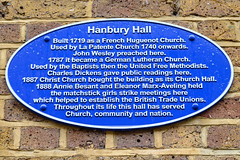Annie Besant
Annie Besant
(1847-1933)
Commemorated on 3 plaques
Annie Besant 1847-1933 social reformer lived here in 1874
39 Colby Road, London, United Kingdom where they lived
The Match Girls Strike of 1888 was led here by Annie Besant journalist and lecturer 1847-1933 Following the strike, Annie Besant became Secretary of the new Matchmakers Union. In 1917 she became President of the Indian National Congress and was also International President of the Theosophical Society from 1907-1933.
Fairfield Works, Fairfield Road, Bow, London, United Kingdom where they led the Match Girls Strike
Hanbury Hall Built 1719 as a French Huguenot Church. Used by La Patente Church 1740 onwards. John Wesley preached here. 1787 it became a German Lutheran Church. Used by the Baptists then the United Free Methodists. Charles Dickens gave public readings here. 1887 Christ Church bought the building as its Church Hall. 1888 Annie Besant and Eleanor Marx-Aveling held the matchstick girls strike meetings here which helped to establish the British Trade Unions. Throughout its life this hall has served Church, community and nation.
22 Hanbury Street Spitalfields, London, United Kingdom where they was (1888)



